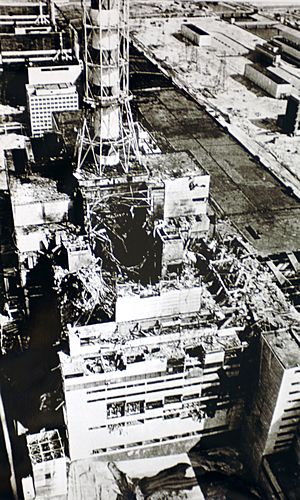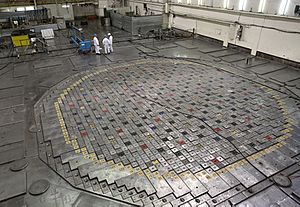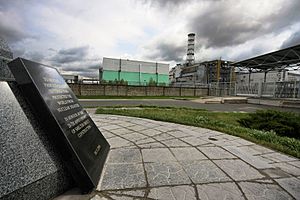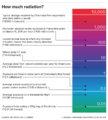Chernobyl disaster facts for kids
The Chernobyl disaster was a terrible nuclear accident. It happened on April 26, 1986, at the Chernobyl nuclear power plant. This plant was near Pripyat, Ukraine. Back then, Ukraine was part of the Soviet Union.

It was one of the worst accidents ever. It got the highest rating, Level 7, on a scale for nuclear events. Only the Fukushima accident in Japan has also been rated Level 7. The RBMK reactors at Chernobyl did not have a special building. This building, called a containment building, would normally keep radiation inside. Because there was no containment building, radioactive dust and particles spread far away. This "fallout" drifted over parts of the Soviet Union, Eastern Europe, Scandinavia, the UK, and even the eastern United States.
Large areas of Ukraine, Belarus, and Russia became very contaminated. About 60% of the radioactive fallout landed in Belarus. Around 360,000 people had to move from their homes. They needed to find new places to live after the accident. Many people also suffered from long-term illnesses. Some were diagnosed with thyroid cancer and acute radiation poisoning.
Contents
What Happened During the Accident?
The accident happened during a planned test. Workers were going to reduce the power of the fourth reactor. They wanted to see if the reactor could still cool itself down. This test was meant to improve safety.
The Test Goes Wrong
Before the accident, the power level was lowered. A regional power station went offline unexpectedly. This meant the Chernobyl plant was needed more. So, the power reduction was asked to be postponed. However, the test preparations continued anyway.
The reactor's power dropped too low. This made the reactor unstable. The operators then tried to increase the power too quickly. They also switched off some safety systems. These systems would normally stop the reactor from exploding.
The Explosion
Suddenly, the fourth reactor's power shot up very high. This caused a huge explosion inside the reactor. The explosion was so strong it blew off the reactor's 1000-ton steel lid. This released a lot of radioactive materials and fuel. The explosion also caused the neutron moderator, made of graphite, to catch fire. The fire burned for many days. It released even more radioactive fallout into the air. This smoke carried the radiation far away.
After the Disaster
After the explosion, Reactor 4 was covered. A huge structure called a "sarcophagus" was built over it. This sarcophagus was made of steel and concrete. Its job was to stop more radiation from escaping. It contained dangerous materials like corium, uranium, and plutonium. In 2016, a new, stronger structure was built over the old sarcophagus. It is called the New Safe Confinement.
Impact on the Soviet Union
The Chernobyl accident made people worry about nuclear power safety. The Soviet Union slowed down its nuclear energy plans. The government also had to become less secretive. This was a big change for them. Today, Ukraine, Russia, and Belarus are separate countries. They still face high costs for cleaning up the radiation. They also have to pay for health care for affected people. Being exposed to radiation can increase the risk of getting cancer.
How Many People Were Affected?
It is hard to know the exact number of deaths from Chernobyl. Many people affected have not died yet. If they die from cancer later, it's hard to prove it was only because of the accident.
A report from the IAEA in 2005 said 56 people died directly. This included 47 accident workers and 9 children. The children died from thyroid cancer. The report also estimated that up to 4,000 people might die from long-term illnesses. Other groups have higher estimates. The Union of Concerned Scientists or Greenpeace think between 93,000 and 200,000 people died.
The Other Reactors
The other three reactors at Chernobyl kept working for a while. Ukraine needed their power. Reactor 2 was shut down in 1991 after a fire. Reactor 1 was shut down in 1996. Reactor 3 was shut down in 2000. In 2018, a large solar power plant was built near the old nuclear plant. It uses 3800 solar panels to make electricity.
Related pages
Images for kids
-
Pieces of graphite were thrown from the reactor core. The largest piece shows a control rod channel.
-
Pripyat with the Chernobyl Nuclear Power Plant in the distance.
-
After the disaster, a pine forest turned reddish-brown and died. It was called the "Red Forest". This photo was taken in 2009 after the forest started to grow back.
-
Pripyat is abandoned, with the Chernobyl facility visible far away.
-
Portraits of deceased Chernobyl liquidators. These were used in an anti-nuclear protest in Geneva.
See also
 In Spanish: Accidente de Chernóbil para niños
In Spanish: Accidente de Chernóbil para niños



































